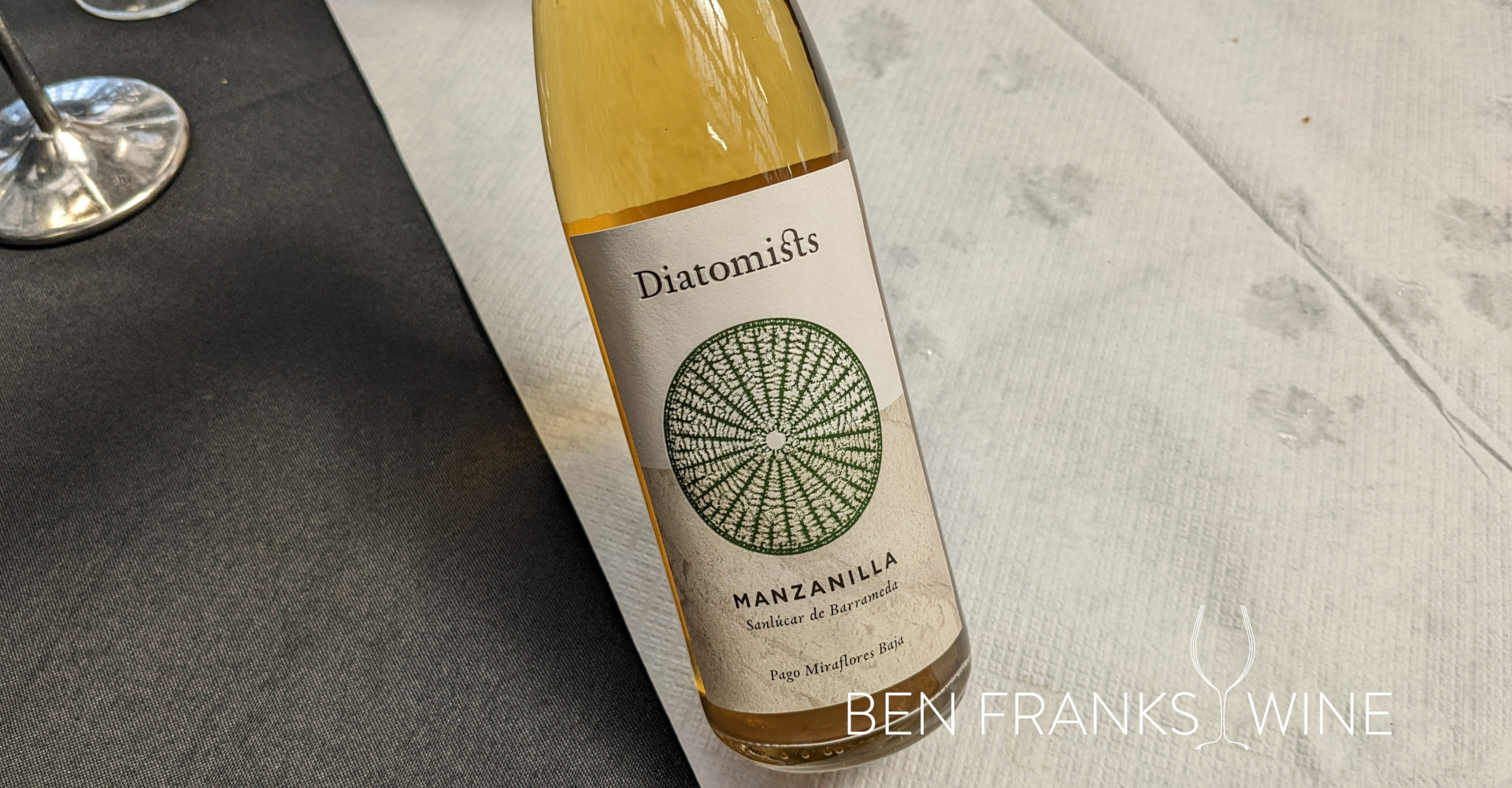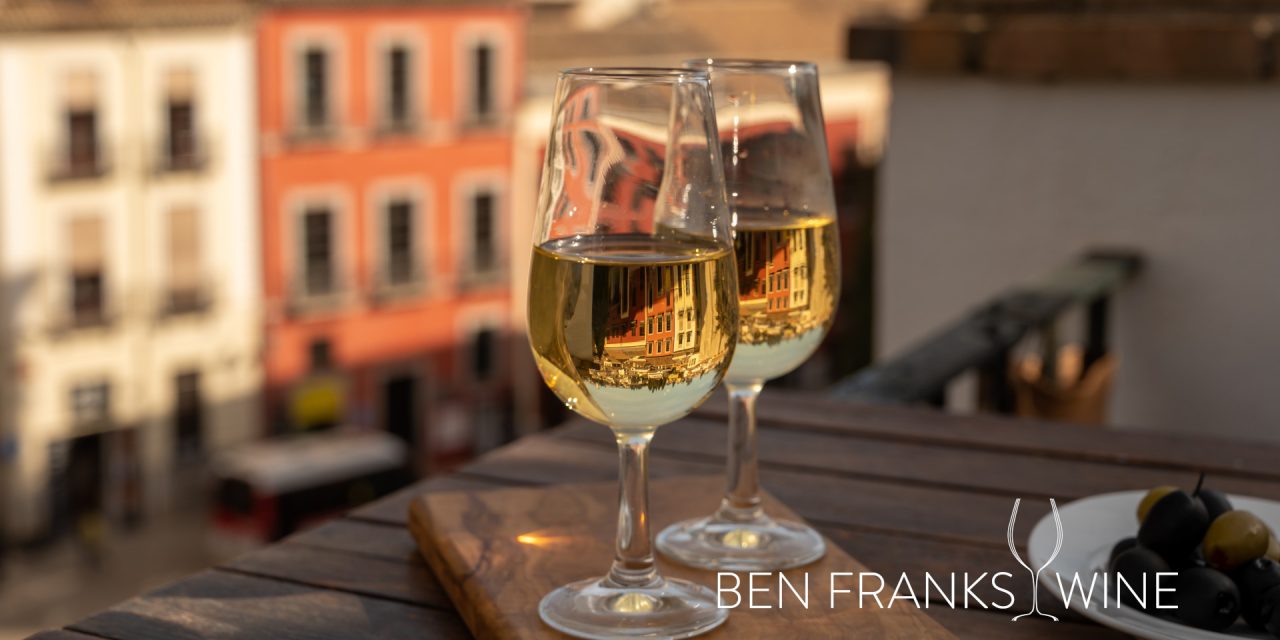We’ve been asking the question for decades, but is it finally time for sherry’s comeback? In Oliver Coleman‘s debut article for Ben Franks Wine, he explores the changing aims of sherry producers. Could terroir and gourmet pairings return sherry to its place amongst the greats, like Burgundy and Champagne?
Antonio Morenés Bertrán of Diatomists is sanguine but realistic about the wines from his home region of Jerez. ‘We’ve got everything going for us, but we still have some convincing to do,’ he tells me. Indeed. The often-heralded new wave of sherry has been on the verge of breaking over the heads of wine drinkers for much of the past twenty years. And yet, despite receiving the plaudits of the wine trade in that time, sherry has not managed to restore its reputation in the pantheon of great wine regions.
In truth, the poor standing and image problems of sherry are largely self-inflicted; massive companies, over-planting and over-producing from the 1970s onward, flooded the market with cheap, dilute, sweetened sherries, which made a mockery of a wine that, in its 19th-century heyday, sat cheek-by-jowl with champagne on the grandest wine lists of Paris.
Recapturing that position is the aim of the small but growing band of quality-focused sherry producers and bottlers. And why not? Jerez has all the elements that many upcoming wine regions would kill for: centuries of history and stories, a unique style of winemaking, and distinctive terroirs to be explored and tasted.
Given all this, and at the risk of sounding like one of the previous false prophets of the sherry revival, I think that Jerez’s moment may be close at hand.
Albariza: the white stuff
As with so many recent happenings in the world of wine, the sherry revolution has been conceived in the remembrance of things past. The intrepid vanguard of the revolution, names such as Willy Perez (Bodegas Luis Perez), Ramiro Ibáñez (Cota 45), Peter Sisseck (Viña Corrales), Alejandro Muchada (Muchada-Léclapart), and Diatomists are all emphatic that sherry was once all about soils.
This soil in question is, of course, the famous white albariza of the El Marco (sherry triangle) – as every good WSET student knows. But using albariza as a catch-all term oversimplifies a soil that was classified into three different types nearly two centuries ago. In the 19th century, the sherry region was divided into various named vineyards based on soil, altitude, and aspect. There was, in other words, a deep recognition that different sites were reflected in the final wine; the price paid to growers back then was stratified according to location, not yield (think Champagne).
That place-equals-quality seems like an obvious observation in modern wine but, for much of the last fifty years in Jerez, the emphasis has been on the winemaking (and, more specifically, the ageing process) in the bodega, rather than the provenance of the grapes themselves. Happily, this is changing and the evocative names of individual pagos (vineyard sites) are now proudly displayed on the labels of new-wave sherry producers. Names such as Miraflores, Macharnudo, Balbaina are among the most frequently cited, but there are around 60 pagos in all. In other words, for terroir geeks (of which I am one) this is a lifetime of tasting exploration.
It will take time for the names of these pagos to be associated with particular expressions of sherry and fixed in the minds of fine-wine customers, but the producers’ enthusiasm and knowledge of these sites is exceptional and infectious. Even the leading bodegas are starting to see the benefits of this approach – Hidalgo’s Manzanilla Pastana or Valdespino’s Inocente are both notable and widely available examples.
Palomino and its discontents
While disregarding terroir may be sherry’s original sin, the trials and tribulations of the region’s main grape variety (Palomino Fino) are a similar tale of woe.
Palomino is often maligned as a ‘neutral’ grape variety, the perfect blank canvas on which the solera and bodega can paint their expressive colours. But, says Diatomists’ Antonio, this is simply ‘not true – it’s really not neutral’. He speaks of the ‘super-expressive’ intense tropical-fruit notes on the wines from his family’s low-yielding vines. And this is the important bit: yield. Clones of Palomino were developed in the 1970s that could crop at very high levels. When yield, not quality or location, was the desirable characteristic of a grape variety everything else was forgotten. There aren’t many grapes that can deliver intensity and complexity at 15,000 tonnes per hectare.
But getting down to the lower yields requires a complete rethink of viticulture in the region. Most growers simply sell to the local cooperative, where they are paid by weight. And they aren’t paid much (around 60 cents per kilo), which is a fraction of what growers might get in Champagne or Burgundy.
It is challenging to say the least to improve viticultural practices when the incentives are currently so low. Even for the cooperatives or larger sherry makers, the perception still abounds that any faults in the grapes can be rectified by the long ageing process. That said, change is slowly coming; smaller bodegas and growers are starting to see the increasing impact that careful producers are having on the market and the prices of their grapes.
Vino de Pasto
The inevitable consequence of the return to the soil and high-quality viticulture is the renaissance of a largely forgotten style of wine from Jerez, vino de pasto. This term was used to describe unfortified sherries that were largely drunk locally. They fell out of favour after phylloxera decimated the region, but they are now making a very welcome return. They are the perfect vinous vehicle to explore the terroirs of Jerez; without the interference of long solera ageing or heavy fortification, they give maximum expression to the grape and soils, yet often still with more than a nod to the salty, yeasty tang so redolent of sherry.
Currently, there are differing styles within this loose category, but the common thread is that they are unfortified. Some undergo a form of biological ageing under flor, as a fino or manzanilla would (Cota 45 UBE Miraflores is great entry point for this style). The grapes are given some extra time in the sun (the traditional asoleo process), which increases the sugars and therefore alcohol in the final wine to the 15% needed for the flor to develop. Other wines are vinified as other table wines but are aged in ex-fino casks (Barbadillo’s Patinegro, to take one example) to provide the wines with the tell-tale flor-derived accent of a fino or manzanilla.
Whither the bodega?
The re-appearance of unfortified sherries does not mean, however, that the traditionally fortified and aged styles are passé. On the contrary, they are playing a central role in the revival of sherry’s fortunes, too. One could argue that the beginning of the sherry revolution began with Equipo Navazos searching out the very best individual soleras and botas, some of which have been aged for a very long time and putting them on the market at a price commensurate with their quality – a rare thing in the generally under-priced sherry category. Leading bodegas have contributed, too, with Barbadillo Reliquia series or the Almacenista bottlings from Lustau excellent examples among many.
The complexity, intensity and length of these wines are breathtaking; they are true meditation wines to be sipped reverently and with great attention. However, some argue that to succeed in reaching a broader audience – one that is not won over easily by the heady delights of an aged Oloroso – an approach to the bodega work that emphasises freshness, fruit and vinosity is the answer.
For those who are looking for terroir and varietal expression in their wines, Antonio gives a warning: ‘the solera system is genius … but it’s a trap’. For Diatomists wines, currently all fortified (though a vino de pasto is on the way), the aim is to produce a sherry that ‘emphasises drinkability, that’s food-driven and super-fresh’. The way they achieve this is, in part, to ensure that the wines are not aged for too long. Their amontillado is aged for around 12 years – a relatively short time for the category – but, while it still has the biological and oxidative characters of a classic amontillado, these characteristics support and frame the beautiful fruit expression, which sings from the glass. You feel you are drinking a wine, rather than something more akin to an aged whiskey.
Winning over the market
The issue, as Antonio sees it, is that for many of the traditional sherry-drinkers in the UK market, the longer the wine is aged, the better it is – an issue in Spanish wines more generally, where the use of ageing categories has, perhaps erroneously, grown into an indicator of quality.
Still, the pockets of resistance are giving way to a younger audience that is proving receptive to the newer, fresher, more approachable sherries or the vino de pasto style. A large part of this growing interest comes from how incredibly versatility younger sherries are as a partner to food, beyond the olive-and-anchovy stereotype. When shown with food, Antonio says ‘it’s easy to win them over’. I can certainly attest that some of the best wines I’ve had with hard-to-pair spreads of Japanese food have been younger sherries.
The other tactic for winning over the market will be traceability. As viticultural practices improve, as the focus on better bodega work ramps up, producers will be able to give consumers the insights into every stage of the winemaking process and, thereby, be able to point to why a given sherry tastes exactly the way it does. Again, this is standard practice in most fine-wine regions but sherry has, up until recently at least, been lagging.
There won’t be a return to the dizzying heights of the 19th century – there’s too much great wine sloshing around the globe for that to happen. Nor will the mass-market appeal of sherry come back (and a good thing, too!). Instead, sherry could become a gourmet wine-drinkers heaven, something to explore and ruminate over, a wine that demands respect and receives, in return, the attention – and prices – it so richly deserves. The pieces may now be in place for sherry’s revival – perhaps more so than at any point in the last fifty years. ‘The bodegas put us on the map, but the work on the soil will take us back to where we belong,’ says Antonio. Indeed, it will.
~
What’s your recent experience of sherry? Let us know in the comments below.

Revisiting Diatomists
Ben Franks tasted Diatomists range in 2022. You can read his reviews here:
NV Manzanilla Sanlúcar de Barrameda Miraflores Baja ★ Good Wine “Golden for Manzanilla with baked apple and more fruit-focused aromas than I was expecting. Citrus peel, nuts, and fresh hay with salinity on the finish.” Read full review.
NV Medium Sherry Jerez de la Frontera ★★ Great Wine “Wow, what a superb example of Medium sherry. Pours as an immediately attractive golden caramel colour and leads with aromas of dried fruits, nuts, spice and biscuit. A little note of raisins on the palate is backed by rounded, dried fruits and voluptuous texture. If nothing else, this is one very satisfying glass of wine.” Read full review.
NV Amontillado Jerez de la Frontera ★★ Great Wine “Beautiful colour and very aromatic. Dried peach, red apple, nuts and toast on the nose. Followed up by a palate that’s both vibrant (dried citrus, tangy apricots) and mature (toasted nuts, caramel) and finishing with saline freshness. One of the best Amontillados I’ve had.” Read full review.
NV Oloroso Jerez de la Frontera ★★★ Outstanding Wine “Let me forewarn you – I will gush over this wine. Slick, caramel coloured liquid with brilliant, vibrant aromas of caramelised nuts, wood spice, flecks of vanilla, and dried fruit. The palate is surprisingly fresh, given its been aged for 12 years, with packs of prunes, soft tobacco hues, sweet almonds and walnuts, and orange peel. A long, off-dry finish. Superb and easily Diatomists’ best wine yet.” Read full review.
NV Pedro Ximénez ★★ Great Wine “Exactly what good PX should be! Raisin coloured and sticky textured but surprisingly moreish with every sip. Full of prunes, cloves and vanilla.” Read full review.






